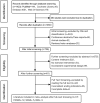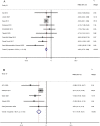Efficacy and feasibility of aerobic exercise interventions as an adjunctive treatment for patients with schizophrenia: a meta-Analysis
- PMID: 38167923
- PMCID: PMC10851701
- DOI: 10.1038/s41537-023-00426-0
Efficacy and feasibility of aerobic exercise interventions as an adjunctive treatment for patients with schizophrenia: a meta-Analysis
Abstract
Schizophrenia is a chronic mental disorder primarily treated with antipsychotics, which have limited efficacy for negative symptoms. This study aims to evaluate the effectiveness and feasibility of exercise interventions as adjuncts to pharmacotherapy through a meta-analysis, providing valuable insights for rational intervention design. Four databases were searched, and randomized controlled trials with no language restrictions published up to March 27, 2023, were included. The primary outcome indicator was the Positive and Negative Symptom Scale (PANSS) total score along with its three sub-scales. Secondary outcomes included the Scale for Assessment of Negative Symptoms (SANS) and Body Mass Index (BMI), which were used to assess the efficacy of aerobic exercise interventions in patients with schizophrenia. Subgroup analyses were conducted to explore the impact of intervention duration and total weekly exercise time, while treatment feasibility was assessed through adherence rates. A total of 17 publications involving 973 patients with schizophrenia were deemed eligible and included in the analysis. Compared to other forms of adjunctive interventions, the network meta-analysis of 12 PANSS-based studies revealed that adjunctive aerobic exercise interventions were the most effective in reducing overall PANSS scores in patients with schizophrenia, with statistically significant pooled results (MD = -4.84, 95% CI: -5.72, -3.96). Both the PANSS negative symptom subscale (MD = -2.11, 95% CI: -3.26, -0.95) and SANS (MD = -9.11, 95% CI: -11.94, -6.27) indicated that adjunctive aerobic exercise interventions effectively alleviate negative symptoms. Subgroup meta-analysis indicated that 2-3 month interventions involving 100-220 min of exercise per week were the most effective. Additionally, adherence to the adjunctive aerobic exercise regimen was found to be comparable to that of conventional treatment alone. Aerobic exercise interventions, as adjunctive therapy, are an effective measure for reducing PANSS scores in patients with schizophrenia, contributing to the alleviation of both the positive and negative symptoms, and patients demonstrated strong adherence to aerobic exercise.
© 2024. The Author(s).
Conflict of interest statement
The authors declare no competing interests.
Figures






Similar articles
-
Effects of Aerobic, Resistance, and Combined Exercise Training on Psychiatric Symptom Severity and Related Health Measures in Adults Living With Schizophrenia: A Systematic Review and Meta-Analysis.Front Cardiovasc Med. 2022 Feb 8;8:753117. doi: 10.3389/fcvm.2021.753117. eCollection 2021. Front Cardiovasc Med. 2022. PMID: 35211516 Free PMC article.
-
Tai Chi for Schizophrenia: A Systematic Review.Shanghai Arch Psychiatry. 2016 Aug 25;28(4):185-194. doi: 10.11919/j.issn.1002-0829.216051. Shanghai Arch Psychiatry. 2016. PMID: 28638191 Free PMC article.
-
Initial severity of schizophrenia and efficacy of antipsychotics: participant-level meta-analysis of 6 placebo-controlled studies.JAMA Psychiatry. 2015 Jan;72(1):14-21. doi: 10.1001/jamapsychiatry.2014.2127. JAMA Psychiatry. 2015. PMID: 25372935
-
Effect of Community-Based Social Skills Training and Tai-Chi Exercise on Outcomes in Patients with Chronic Schizophrenia: A Randomized, One-Year Study.Psychopathology. 2016;49(5):345-355. doi: 10.1159/000448195. Epub 2016 Sep 2. Psychopathology. 2016. PMID: 27584836 Clinical Trial.
-
Estradiol and raloxifene as adjunctive treatment for women with schizophrenia: A meta-analysis of randomized, double-blind, placebo-controlled trials.Acta Psychiatr Scand. 2023 Apr;147(4):360-372. doi: 10.1111/acps.13530. Epub 2023 Jan 27. Acta Psychiatr Scand. 2023. PMID: 36585771 Review.
Cited by
-
Effects of aerobic exercise on hippocampal formation volume in people with schizophrenia - a systematic review and meta-analysis with original data from a randomized-controlled trial.Psychol Med. 2024 Nov 18;54(15):1-12. doi: 10.1017/S0033291724001867. Online ahead of print. Psychol Med. 2024. PMID: 39552395 Free PMC article. Review.
-
Systematic review and meta-analysis of the effects of EEG neurofeedback combined with pharmacological treatment on the positive and negative symptoms in patients with schizophrenia.Front Psychiatry. 2025 Mar 28;16:1537329. doi: 10.3389/fpsyt.2025.1537329. eCollection 2025. Front Psychiatry. 2025. PMID: 40225850 Free PMC article.
-
EPA guidance on lifestyle interventions for adults with severe mental illness: A meta-review of the evidence.Eur Psychiatry. 2024 Dec 10;67(1):e80. doi: 10.1192/j.eurpsy.2024.1766. Eur Psychiatry. 2024. PMID: 39655999 Free PMC article.
References
LinkOut - more resources
Full Text Sources

